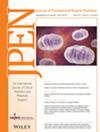Indirect calorimetry in traumatically injured patients: A descriptive cohort study
Abstract
Background
Trauma patients have historically been considered profoundly hypermetabolic. The purpose of this study was to describe energy expenditure using indirect calorimetry and to compare indirect calorimetry to predictive equations in trauma patients.
Methods
Indirect calorimetry was performed using a Q-NRG+ by a trained dietitian nutritionist. Results were obtained in mechanically ventilated trauma patients between September 2023 and June 2024. Demographic data, injury characteristics, and outcomes were collected. Results were compared with energy expenditure predicted with 20, 25, and 30 kcal/kg; Penn State 2003b; and Schofield in adolescents on the day of indirect calorimetry using the Wilcoxon test. Subanalysis was completed in adolescents and older adults. Energy expenditure was evaluated over time.
Results
A total of 164 indirect calorimetry results from 117 patients were analyzed. Among participants, median age was 43 (28–62) years, 85% were with blunt mechanism of injury, and and 80% were male. Median energy expenditure was 1869 kcal/day (1618–2265 kcal/day). In the full cohort, 20 kcal/kg underestimated energy needs, whereas other equations overestimated needs. In adolescents, 25 kcal/kg and Schofield were not significantly different than indirect calorimetry (P = 0.15 and 0.64). In older adults, 20 kcal/kg was not significantly different from indirect calorimetry (P = 0.58). A weak association was observed between prescribed and measured energy (r = 0.32, P < 0.001).
Conclusion
Predictive equations recommended in critical care do not accurately reflect energy expenditure in trauma patients. Indirect calorimetry remains the preferred method for determining energy needs and the availability of the bedside dietitian nutritionist to perform these assessments facilitates timely, serial testing.




 求助内容:
求助内容: 应助结果提醒方式:
应助结果提醒方式:


